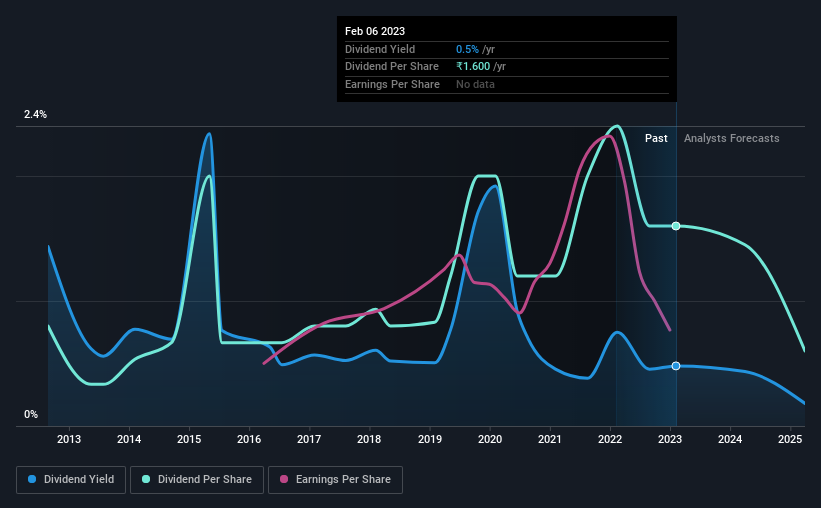
The board of Hikal Limited (NSE:HIKAL) has announced it will be reducing its dividend by 50% from last year's payment of ₹1.20 on the 4th of March, with shareholders receiving ₹0.60. This means that the dividend yield is 0.5%, which is a bit low when comparing to other companies in the industry.
Check out our latest analysis for Hikal
Hikal's Payment Has Solid Earnings Coverage
If it is predictable over a long period, even low dividend yields can be attractive. Hikal is quite easily earning enough to cover the dividend, however it is being let down by weak cash flows. With the company not bringing in any cash, paying out to shareholders is bound to become difficult at some point.
According to analysts, EPS should be several times higher next year. Assuming the dividend continues along recent trends, we think the payout ratio will be 6.7%, which makes us pretty comfortable with the sustainability of the dividend.

Dividend Volatility
The company's dividend history has been marked by instability, with at least one cut in the last 10 years. The dividend has gone from an annual total of ₹0.80 in 2013 to the most recent total annual payment of ₹1.60. This works out to be a compound annual growth rate (CAGR) of approximately 7.2% a year over that time. We have seen cuts in the past, so while the growth looks promising we would be a little bit cautious about its track record.
The Dividend's Growth Prospects Are Limited
Given that the dividend has been cut in the past, we need to check if earnings are growing and if that might lead to stronger dividends in the future. Over the past five years, it looks as though Hikal's EPS has declined at around 4.0% a year. If the company is making less over time, it naturally follows that it will also have to pay out less in dividends. Earnings are forecast to grow over the next 12 months and if that happens we could still be a little bit cautious until it becomes a pattern.
The Dividend Could Prove To Be Unreliable
In summary, dividends being cut isn't ideal, however it can bring the payment into a more sustainable range. With cash flows lacking, it is difficult to see how the company can sustain a dividend payment. This company is not in the top tier of income providing stocks.
Investors generally tend to favour companies with a consistent, stable dividend policy as opposed to those operating an irregular one. Still, investors need to consider a host of other factors, apart from dividend payments, when analysing a company. For example, we've picked out 3 warning signs for Hikal that investors should know about before committing capital to this stock. If you are a dividend investor, you might also want to look at our curated list of high yield dividend stocks.
Valuation is complex, but we're here to simplify it.
Discover if Hikal might be undervalued or overvalued with our detailed analysis, featuring fair value estimates, potential risks, dividends, insider trades, and its financial condition.
Access Free AnalysisHave feedback on this article? Concerned about the content? Get in touch with us directly. Alternatively, email editorial-team (at) simplywallst.com.
This article by Simply Wall St is general in nature. We provide commentary based on historical data and analyst forecasts only using an unbiased methodology and our articles are not intended to be financial advice. It does not constitute a recommendation to buy or sell any stock, and does not take account of your objectives, or your financial situation. We aim to bring you long-term focused analysis driven by fundamental data. Note that our analysis may not factor in the latest price-sensitive company announcements or qualitative material. Simply Wall St has no position in any stocks mentioned.
About NSEI:HIKAL
Hikal
Manufactures and sells various chemical intermediates, specialty chemicals, and active pharma ingredients to pharmaceutical, animal health, biotech, crop protection, and specialty chemicals companies in India, the United States, Canada, Europe, South East Asia, and internationally.
Reasonable growth potential with proven track record and pays a dividend.
Similar Companies
Market Insights
Community Narratives





